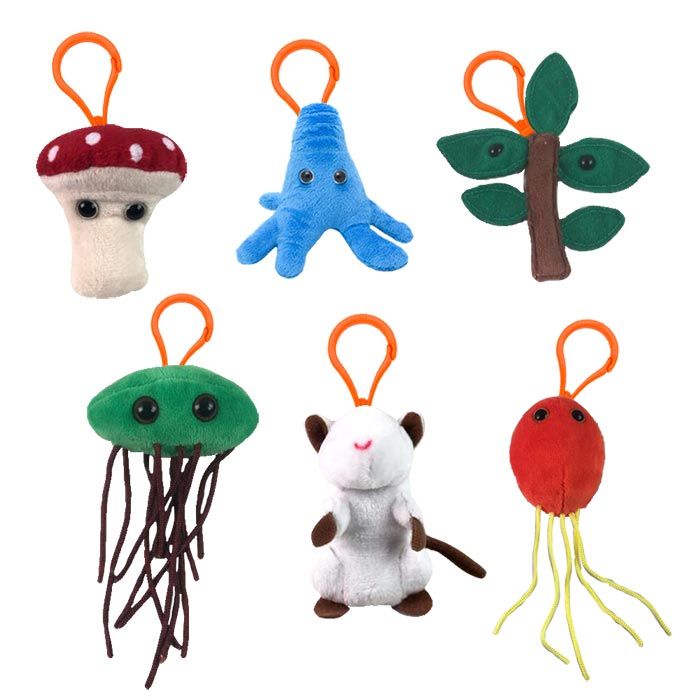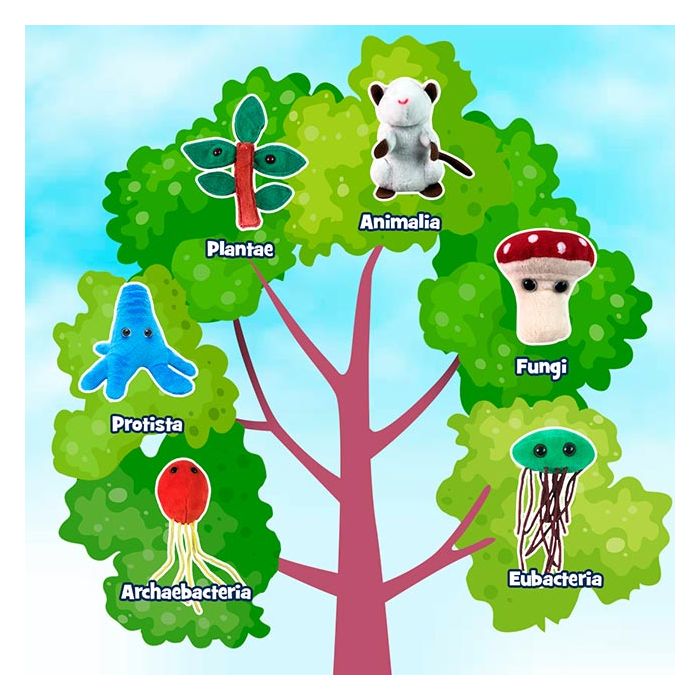Kingdoms of Life
Out of Stock
Whether having one cell or many, manufacturing food or eating others, or getting by parasitically or symbiotically, all life is remarkable – arguably the most amazing thing in the universe. Blue whales and red wood trees are hugely impressive, while amoeba, E.coli and other microbes are exquisitely small with an outsized impact on the world. And don’t feel bad for viruses which are not really alive at all. They get plenty of attention these days even without a kingdom of their own.
Kingdoms of Life pack includes one representative from each of the six kingdoms in mini key chain size: Mus musculus mouse from Animalia, Zamioculcas zamiifolia from Plantae, Amanita muscaria mushroom from Fungi, Amoeba proteus from Protista, Pyrococcus furiosus from Archaebacteria and E.coli from Eubacteria.
Product Details
Additional Information
| Sizes | Giantmicrobes are based on actual microbes, cells, organisms and other critters, only 1,000,000 times actual size! Gigantic (GG) 16-24" XL (XL) 10-15" Original (PD) 5-8" Keychain (KC) 2-4" with clip |
|---|---|
| Materials | Plush from all new materials. Stuffed with polyester fiber fill. Surface washable: sponge with water & soap, air dry. |
| Packaging | Each plush microbe includes a printed card with fun, educational and fascinating facts about the actual microbe or cell. |
| Safety | Every product meets or exceeds U.S. and European standards for safety. For ages 3 and up. |
All about Kingdoms of Life
ANIMALIA - All species on Earth can be categorized into six kingdoms of life: animals, plants, fungi, protists, bacteria and archaea. The Animalia kingdom includes millions of species, ranging from jellyfish to mice and humans. Animals are multicellular and heterotrophic, meaning they eat other organisms. Most have different tissues made up of complex cells containing a nucleus and other organelles. Some people talk to animals, but not many listen though.
ARCHAEBACTERIA - All species on Earth can be categorized into six kingdoms of life: animals, plants, fungi, protists, bacteria and archaea. The kingdom of Archaebacteria, or ancient bacteria, are single-celled microbes with cell walls and RNA that differ from bacteria. Archaea and bacteria are both prokaryotes, meaning their cells have no membrane-bound organelles. Many archaea are extremophiles, living in extreme environments such as deep sea thermal vents, ice, volcanoes or hot springs.
EUBACTERIA - All species on Earth can be categorized into six kingdoms of life: animals, plants, fungi, protists, bacteria and archaea. The kingdom of Eubacteria, or true bacteria, are single-celled microbes that arose billions of years ago. Bacteria and archaea are prokaryotes, meaning their cells are simple with no membrane-bound organelles. Bacteria such as E. coli and salmonella cause disease, but most are beneficial to people and our planet.
FUNGI - All species on Earth can be categorized into six kingdoms of life: animals, plants, fungi, protists, bacteria and archaea. The Fungi kingdom includes yeasts, molds and mushrooms, whose beauty, edibility and peril catch the imagination of poets and scientists alike. While plantlike, fungi are more similar to animals. Fungi eat using enzymes to digest the food they find externally before absorbing it into their mycelia. Some are free-living in soil or water, others form parasitic or symbiotic relationships with plants or animals.
PLANTAE - All species on Earth can be categorized into six kingdoms of life: animals, plants, fungi, protists, bacteria and archaea. The Plantae kingdom ranges from tiny mosses to giant redwood trees. Vital to all life, plants enable us to eat, make medicine and breathe. Plant cells have organelles similar to animal cells. They also have a cell wall and chloroplasts giving plants photosynthetic powers to make their own food. Water and sunshine are to plants what love and work are to people.
PROTISTA - All species on Earth can be categorized into six kingdoms of life: animals, plants, fungi, protists, bacteria and archaea. The Protista kingdom includes a diverse collection of microbes. Most are unicellular, such as amoebas, paramecia, algae and slime molds. Protists, fungi, plants and animals are eukaryotes, meaning they have a complex cell structure with a nucleus and other membrane-bound organelles.





